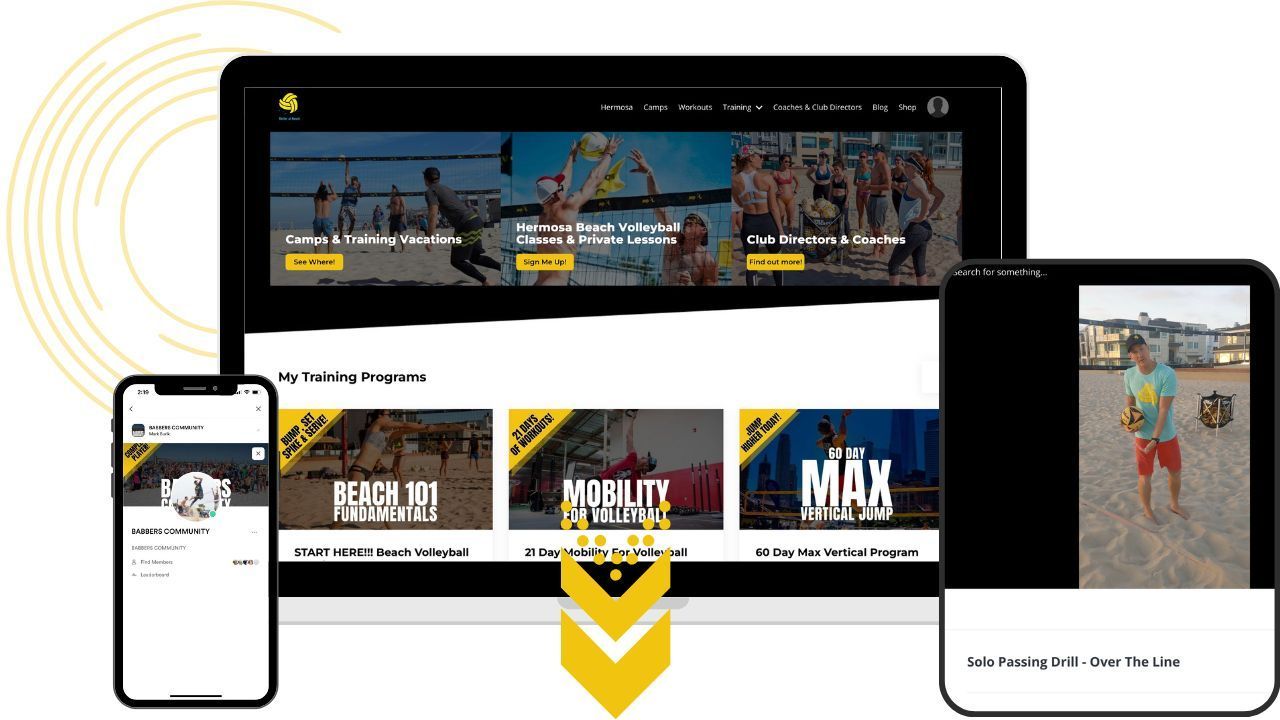
Volleyball Tips | 3 IMPORTANT Things You NEED to Know for Passing, Setting, and Hitting Locations!
It isn’t enough in beach volleyball to simply get a good touch on the ball. That’s half the battle, yes, but only half. The remaining 50 percent of the task?
Where are we supposed to put the ball?
Our touches in beach volleyball must have intention, a direction, a target. Your pass could hit your platform perfectly – but it doesn’t matter if you don’t send the ball to where it will be easiest for your partner to set you. You could have the pearliest of sets, so clean a ref would never once consider blowing the whistle – but it doesn’t matter if you set it behind you or too far outside. You could hit the crispiest of shots, with perfect hand contact – but it doesn’t matter if you hit a balloon to the middle of the court, directly into the laps of the defender.
So, then: Where should we be putting the ball?
Where to pass in beach volleyball
Close your eyes for a second and imagine you're in serve receive: You're standing in the middle half of your side of the court, your partner is standing in the middle half of their respective side. The serve is coming to you. As you prepare to make your pass with perfect form, platform out nice and early, where is your target?
Do you pass to where your partner is standing, which assures a second touch and a set?
Or do you pass to the middle of the court, roughly six feet off the net?
The answer, when written out, seems obvious: Of COURSE you pass to the middle of the court, roughly six feet off the net. This will give your setter time to walk in and set the ball, and it will give you the easiest set to hit, one that is in front of you, not coming over your shoulder.
"You should aim your pass to land about six feet off the net, in the middle of the court, but if you’re going to miss, let’s miss a step on your half of the court," AVP professional beach volleyball player Brandon Joyner said. "This gives our setter an idea of where you plan on passing, and they can then make the movement earlier and get there quicker. I should be aiming to keep the ball on my half, so my setter can run to the ball."
Now that we've passed to our ideal target -- six feet off the net, in the middle of the court -- we come to step No. 2.
Where to set in beach volleyball
Again, I'll ask you to close your eyes. Your partner has just passed a dime, roughly six feet off the net and in the middle of the court. You see your partner step out to their point of preparation, or batter's box. Where do you set your partner?
Do you set the ball outside, to where they are currently standing?
Or do you set roughly in the middle of you two, so your partner can step close and attack with power?
The answer, of course, seems obvious when written out, but oftentimes our brains tell us, incorrectly, to set the ball to where our partner is standing, which seems easier, right? Wrong. Setting to where your partner is standing, or outside of them, will limit their attack, forcing them to make an uncomfortable approach and cut off their angles of attack.
Want to show your support and help us make more content? Buy a cool beach volleyball...
 |
 |
|---|---|
| Tandem Sport Volleyball Quad Blocker |
"More than likely, after our passer passes and they are shuffling away, they want their approach to go cross court, which means they are going to be walking back into the court," Brandon Joyner said. "So if our setter increasingly goes to the sideline, our attacker is going to be chasing it every single time. You should be thinking about keeping the ball in between you and your partner."
Keeping the ball between you and your partner will allow them to make their most explosive approach, giving them power and vision to see the court in front of them.
And when they make their explosive approach, when they see the court in front of them, we come to the final step of the offensive attack in beach volleyball:
Where to place our shots in beach volleyball?
One last time, I'll ask you to close your eyes, though we're doing something different this time. This time, I'll ask you to imagine yourself playing defense. The opposing team has made a good pass and set. The player is approaching hard and is about to hit the ball.
Think: Where do you NOT want them to hit the ball?
Wherever that place is, that's exactly where you should be hitting the ball when you're on offense.
That place has a name, and it's called the alleys, which surround the court: Anywhere three feet from the line is an alley, and it's an excellent shot. Now, Todd Rogers upped the ante a bit, and made his alleys one feet from the line, but three will do for now.
Hitting a shot three feet from any line is almost an assured kill, or at the very least, it's an assured difficult shot for the defense to dig and make a good play on. If you've hit an alley, you've made the defense move. If you've made the defense move, you've done a good job attacking the ball.
"An idea for you to get started: Draw a box inside the court and do a round of around the world or just attacking lines and try to hit every ball within that segment," Brandon Joyner said. "This will get you more comfortable attacking those sidelines."
***
Join our email list and Get your FREE Drill Book > www.betteratbeach.com/freebeachvolleyballdrillbook
If you want to get more power, more accuracy, more consistency and more vision as well as the offensive mindset and strategies that win matches, you should sign up for our Beach Volleyball Mastery. We take you through the basics and then work all the way up to advanced tactics and swing selection to keep the defense on their heels!
We also show you how to find the offense that’s best for YOU and when to use your different attacks so you can beat specific types of players. Once inside the membership, you’ll be able to unlock “Side Out and Win Tournaments: The Attacking Master Class" and “Fix Your Arm Swing in 21 Days" which will build you a new, more powerful, pain-free arm swing from the ground up. It comes complete with rehab protocol, gym exercises you need to increase arm speed, and elite throwing and hitting drills.
We also include with 8 more skill courses AND our 60 Day At-Home Max Vertical Jump Training Program.
Once you sign up, you'll be able to watch the in-depth tutorials, film your “before” videos, start and film your at-home drills and begin posting to our Private Facebook Group. Then, our coaches will break down your mechanics and spacing and timing at our weekly online meetings. Yes, that means we look at YOUR videos and we coach YOU!
Facebook Group CTA VolleyChat! Get Better at Beach Volleyball for posts about common questions/ problems > https://www.facebook.com/groups/betteratbeach
SIGN UP NOW AND LEARN HOW TO WIN FROM THE PROS.





